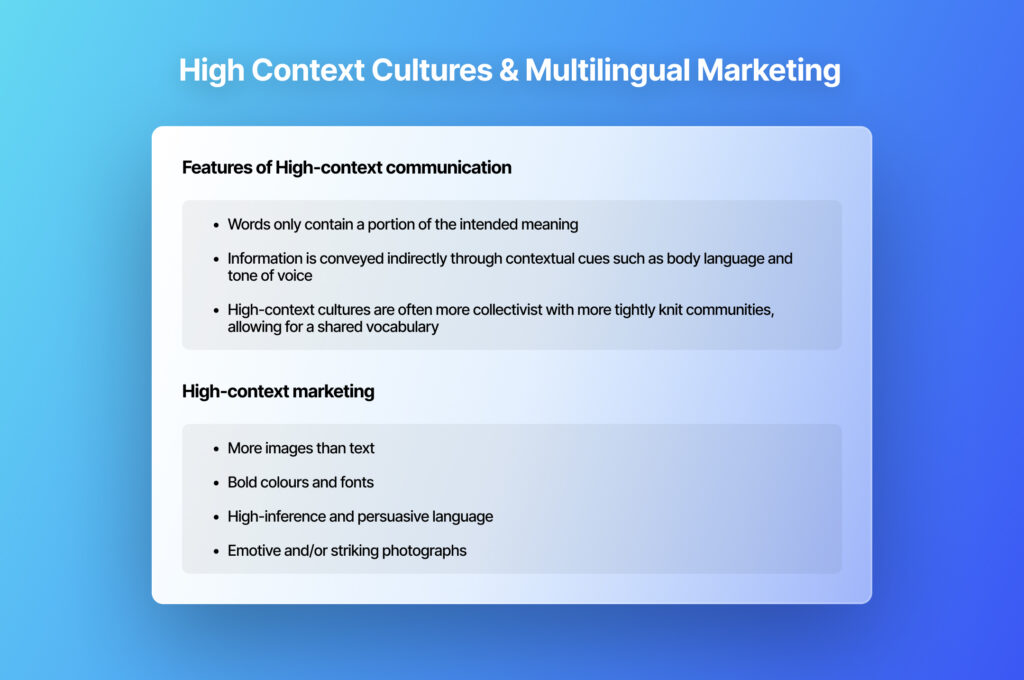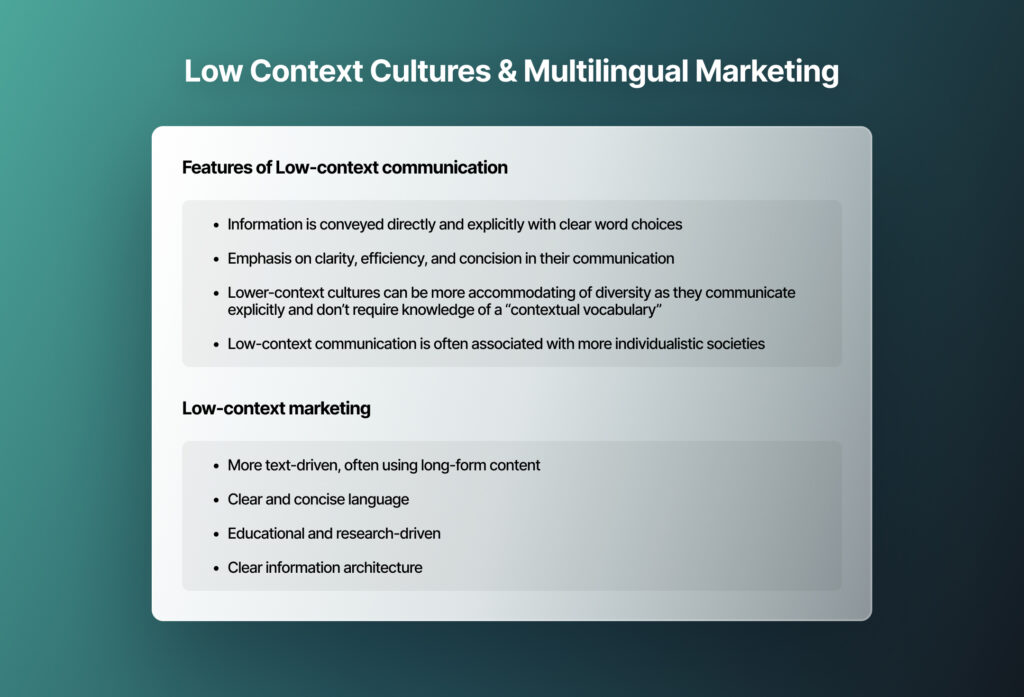Expanding your business internationally opens up a whole new world of opportunities. But it also presents the challenge of adapting your content marketing strategy for a whole new audience. After all, “content is king” no matter what language you’re speaking.
Create a Multilingual Content Marketing Strategy in 6 Steps
In this guide, I’ll explain everything you need to know to prepare your multilingual content marketing strategy. We’ll look at:
- Reviewing your local content marketing strategy
- How to research your international target audience
- Which tools to use for multilingual content marketing
- How to adapt your branding for international markets
- How to write localisation-ready content
- How to localise your design
What is multilingual content marketing?
Multilingual content marketing is content (blogs, videos, images) that generates interest in your brand, products, and/or services. In multilingual content marketing, this content is produced in two or more languages and adapted to suit the tastes and cultures of each targeted region.
So, it’s a bit more complicated than simply translating your content. You need to translate your content in a way that conveys the same message and is appropriate and effective for the culture of your target audience.
Successful multilingual content marketing should:
- Be valuable to your audience
- Represent your brand’s tone of voice
- Be sensitive to cultural differences
- Be optimised for the region you are marketing to
Why is multilingual content marketing important?
Multilingual content marketing is your chance to deeply connect with your audience.
The world, and the internet especially, is increasingly Anglo-centric: English is the most spoken language in the world, and makes up nearly 60% of the internet.
However, according to a report by Common Sense Advisory, not only do most consumers spend nearly all their time on websites in their own language, but 56% of them believe that getting information in their own language is more important than price.
If you make the effort to not only provide content in your audience’s language, but in a way that accounts for their cultural background, you can establish strong relationships with international customers.
Step 1: Review Your Local Content Marketing Strategy
Before you go global, this is the perfect time to review your existing content marketing strategy. It’s easy to fall into the trap of “doing things on the fly” – but that can be wasteful and ineffective. Speaking from experience, you can definitely get results with an improvised strategy, but life gets a lot easier when you have clear goals to work towards.
If you don’t have a whole plan laid out, though, you don’t have to feel too bad. You’re not the only one. Sixty percent of marketers don’t have an overarching strategy for their multilingual content marketing. But, given the size of the investment and its potential returns, it’s wise to go in with a plan in mind.
The first step to establishing your international content strategy, is to review your local strategy.
So before you get stuck in, take a moment to ask yourself these questions:
- How are you trying to present your brand?
- What is your brand’s tone of voice and personality?
- What niches are you targeting?
Having a clear sense of these things will make it easier to purposefully and efficiently translate your content for international markets.
Step 2: Research Your Target Audience
For international content marketing, you’ll need to do a fresh batch of market research. Depending on the country or region you are targeting, you may have to significantly adjust your content to achieve the same effect as it has in your native language.
One of the most important things in multilingual content marketing is taking into account the cultural differences of your target market. Two useful metrics to understand your international audiences are Hofstede’s cultural dimensions theory and low vs high-context cultures.
Hofstede’s cultural dimensions theory
Geert Hofstede’s cultural dimensions theory is used to define the way that people are affected by the culture they live in. It’s also a very popular tool for international marketing and can be instrumental in determining how you approach your multilingual content strategy.
According to Hofstede, cultural preferences can be measured in six dimensions:
- Power Distance Index (PDI): This measures the extent to which people accept the established power structures and hierarchies in their society. A high PDI score indicates that people are content with the distribution of power, whereas a low PDI score indicates that they’re oiling up the guillotine.
- Individualism vs Collectivism (IDV): In an individualistic society, people aren’t closely connected and will prioritise their wellbeing and success. Collectivist cultures on the other hand, place greater importance on the wellbeing of the wider community.
- Uncertainty Avoidance Index (UAI): The UAI refers to a “society’s tolerance for ambiguity”. A culture with a high UAI will be resistant to new ideas and have strict guidelines and rules, based around the idea of an ultimate source of truth. On the other hand, a low UAI society will be more open to new ideas and a lot more fluid in their beliefs.
- Masculinity vs Femininity (MAS): This index measures where a culture aligns with traditional notions of masculine and feminine traits.
- Long-term orientation vs Short-term orientation (LTO): This measures how much a society emphasises the value of planning for the future versus how much they will prioritise short-term goals.
- Indulgence vs Restraint (IND): Does a society allow and encourage people to fulfil their desires and emphasise fun and gratification? Or do they prefer to limit their pleasure-seeking behaviours and instincts?
Hofstede’s model is widely used in fields of intercultural communication. For marketing, it’s a great way to understand the values of a culture and align your brand message with it.
High-Context vs Low-Context Cultures

Another useful metric to think about when adapting content for other regions is the degree of contextual information present in their communication.
High-context communication
This means that only a portion of the information is communicated directly through the speech or text. A lot of the meaning is conveyed through contextual information such as body language, eye contact, and intonation.
High-context cultures rely on a degree of shared knowledge of this contextual vocabulary. As such, they are are often associated with a more collectivist culture.
A perfect example of this is Italians, who add meaning to their words through hand gestures.
(Coming from an Italian family myself, I have to say that it’s quite a sight to behold. Seeing two Italians in a high-spirited conversation is like watching TV with a sign-language interpreter.)
Possibly the most extreme example of high-context communication is memes and “meme culture”, where meaning can be conveyed with very few words or even none at all, simply by juxtaposing images together and relying on knowledge of “inside jokes”.
Content marketing for high-context cultures
High-context marketing relies more on images than words. So, you can adapt your content marketing by using:
- Videos
- Graphics
- Animations
- Emotive or dramatic photographs
- Colourful web design
- Emotional language.
Low-context culture

Low-context communication conveys meaning through direct communication. People will say exactly what they mean. In a lower-context culture, clear and rational communication is favoured over nuance.
Because it doesn’t rely on shared knowledge, low-context communication can be more inclusive. As long as you speak the same language you can hold a conversation with anyone about pretty much anything. Examples of lower-context cultures include Germany, the UK, and the US.
Content marketing for low-context cultures
Content marketing for a low-context culture should appeal more to the rational side of the brain. This includes:
- Clear information architecture
- Educational and informational content
- Research and data-driven content
- Direct and concise language
Of course, countries don’t fall into the extremes of these models. You won’t have an exclusively low-context culture or an exclusively individualistic culture. Countries will fall somewhere on a spectrum with these features and there will be variation between regions. However, these are useful metrics to use when gauging how to promote your brand in a multicultural context.
International marketing research and local ambassadors
While theoretical models are helpful, you should use them as a framework for your own research.
You can carry out market research to collect quantitative data about your target market such as:
- What devices do they primarily use to access the internet?
- What social media platforms are most popular with your target demographic?
- Which content formats are popular?
However, to get a more qualitative understanding of the culture, you should talk to local marketing professionals and consider hiring local brand ambassadors. Having local partners will be enormously helpful in bridging the cultural gap, as they will have an understanding of both your audience’s preferences and of your brand message.
Stefanie Grieser of Unbounce summarised this point quite nicely when she wrote: “The day a brand gets a local ambassador is the day they truly become a local player.”
Step 3: Tools for Multilingual Content Marketing
The majority of the translation work should be done by human translators. With the possible exception of some basic copy, you won’t be relying on machine translation. That being said, there are still some tools you can use to streamline the process.
- Translation Management System (TMS): A TMS helps to manage and organise multilingual content projects. You can track progress and monitor the workflow of your content. This is especially useful if you’re a large organisation with projects in multiple different languages.
- Terminology database: A database for storing frequently used terms such as acronyms, idioms, and jargon.
- Computer Assisted Translation (CAT) tools: This is a system that helps translators and streamlines their workflow. CAT tools will have a translation memory that stores commonly used words and phrases for faster translation, as well as other features to assist in the translation process.
- Localisation-ready CMS: When publishing multilingual content, you must ensure that you have a CMS (Content Management System) that supports localisation functionality.
Step 4: Adapting Your Branding for International Markets
When you’re trying to make your brand’s personality more palatable to other cultures, you have to be careful not to dilute your original message. The core of your brand’s voice should remain consistent across different regions.
Try not to think of it as creating a whole new branding for each country. Rather, find areas where your brand already aligns with the values of the region and highlight those aspects.
For example, on the McDonalds Indian website, they don’t offer any beef products, rather they emphasise their vegan burgers and chicken. Since India is a high-context culture, their website is also a lot more centred around visual elements with large pictures and bold colours. They also prominently feature their local brand ambassador Kartik Aaryan, a famous Indian actor.

If we compare the presentation of the Indian site with the UK version, we can see that the Indian site uses large, colourful fonts, graphics, and catchy, emotive wording, whereas the UK site uses more text with some statistics and a simple layout.

Step 5: Writing localisation-ready content
Part of an effective multilingual content marketing strategy is to create content that is easily localised. As you’ll be working with translators and local copywriters, you want to make content that’s easily transferable into other languages.
Of course, if you’re a multi-billion dollar corporation, you can just have people write separate content for different markets. But to start out, having easily localised content will streamline your workflow and help with budget.
How to write localisation-ready content
Compile a style guide for each language
The more languages you implement, the harder it will be to maintain consistency across all your channels. So compiling a style guide will give you a clear direction and, as you branch out further afield, will ensure that your branding is the same around the world.
Provide contextual information to translators
With multilingual content, it’s not just a translation job but also “transcreation”: where the meaning and intent are semantically translated. When employing translators, the more contextual information you can give them about your brand, target audience, and message, the more accurately they can transcreate your branding.
Avoid overly local references or idioms that will be difficult to translate.
If your brand voice relies on idioms or humour, then it would be best to consult with local translators/partners on the types of idioms/jokes that convey the same message/tone. These could then be compiled into a glossary and included in the style guide.
Step 6: Localise Your Design
Make sure that your web design choices are also accommodating a multicultural approach.
Symbols and colours can have different connotations across different cultures. And different cultural attitudes towards things like gender, clothing, and religion, may mean that some images that are perfectly acceptable to you may be offensive in other cultures.
Colours
Be sure to look into the perceptions of colours in the region you are marketing to.
For example, in the UK and US, the colour green is considered a calming colour and relates to ideas of health, the natural world, and the environment. As a result you will often see this colour used by companies that are marketing healthy products like supplements and health foods.
On the other hand, in China, green is considered an unlucky colour as it is associated with infidelity. A man wearing a green hat is said to have an unfaithful wife.
Symbols
Similarly, symbols and icons may have different meanings in other countries.
When Amazon launched in India in 2018, they were baffled when they realised that many customers were not using the search bar to find products. As it turns out, the magnifying glass icon was the source of the confusion. While we have become accustomed to identifying the magnifying glass with the search function, many Indian audiences did not have that association. In fact, during usability testing, they found that most people thought it was a ping-pong paddle.
Putting it all together…
Multilingual content marketing has the potential to do wonders for any international business. It may seem daunting at first, but at its core it retains the same principles of your regular content marketing. Figure out what your users want and need, and give it to them in a way that they’ll understand and appreciate.
More marketing guides for you:


